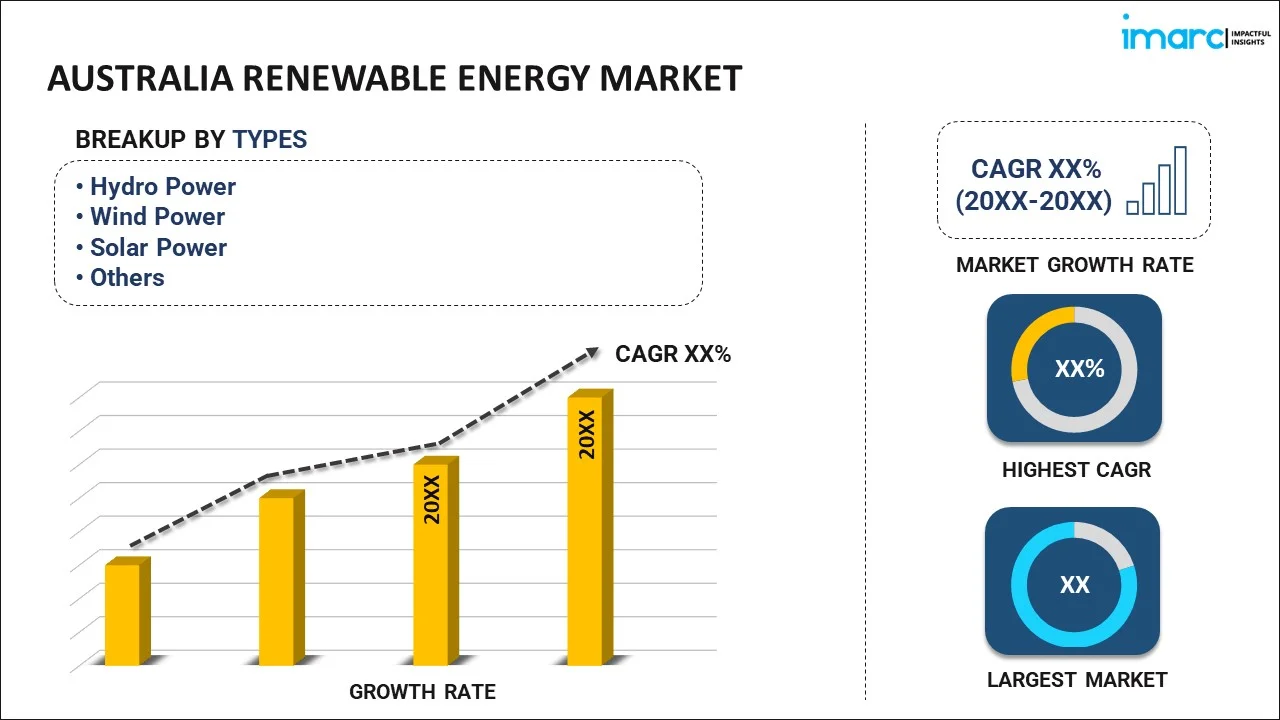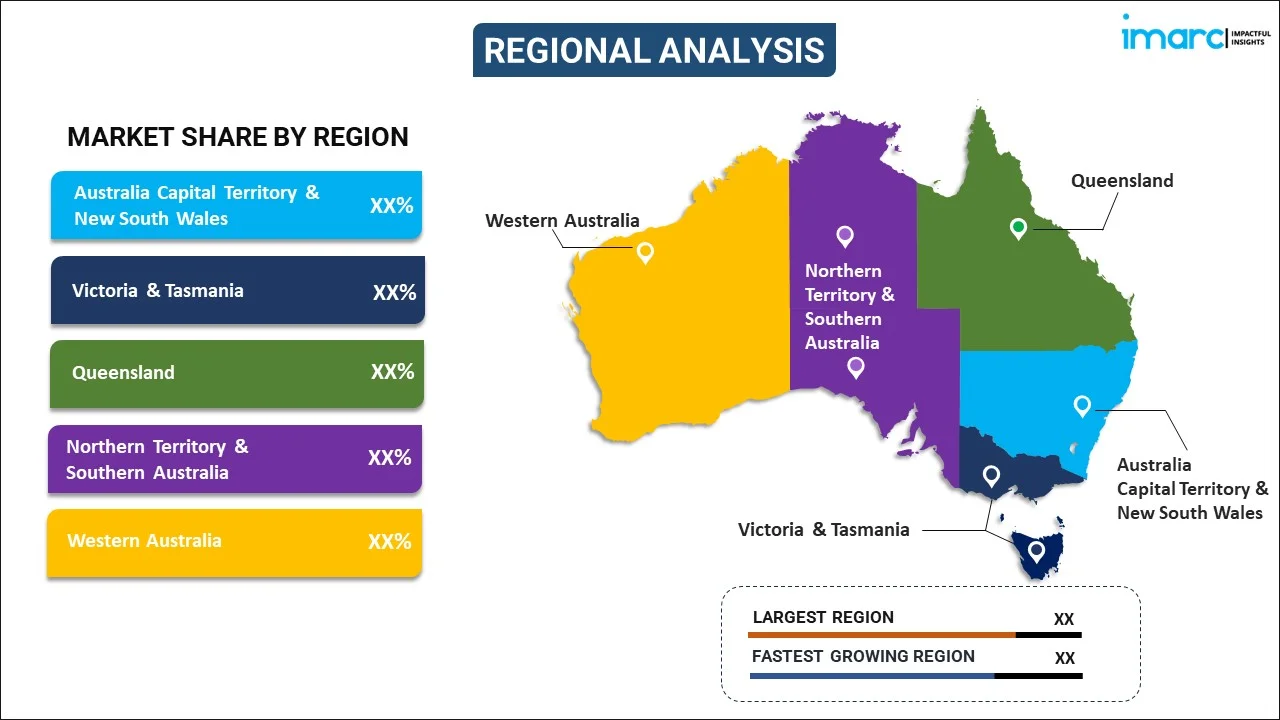
Australia Renewable Energy Market Report by Type (Hydro Power, Wind Power, Solar Power, Bioenergy, and Others), End User (Industrial, Residential, Commercial), and Region 2025-2033
Market Overview:
Australia renewable energy market size reached USD 165.8 Billion in 2024. Looking forward, IMARC Group expects the market to reach USD 687.9 Billion by 2033, exhibiting a growth rate (CAGR) of 16.6% during 2025-2033. The increasing innovation in energy storage, smart grid technologies, and other related areas, which has enhanced the integration and utilization of renewable energy in the broader energy infrastructure, is primarily driving the regional market.
|
Report Attribute
|
Key Statistics
|
|---|---|
|
Base Year
|
2024
|
|
Forecast Years
|
2025-2033
|
|
Historical Years
|
2019-2024
|
|
Market Size in 2024
|
USD 165.8 Billion |
|
Market Forecast in 2033
|
USD 687.9 Billion |
| Market Growth Rate 2025-2033 | 16.6% |
Renewable energy refers to energy derived from naturally replenishing sources that are virtually inexhaustible, promoting sustainability and environmental well-being. Common forms include solar, wind, hydro, geothermal, and biomass energy. Solar power harnesses sunlight through photovoltaic cells, while wind energy captures kinetic energy from wind turbines. Hydropower utilizes flowing water to generate electricity, and geothermal energy taps into Earth's internal heat. Biomass energy derives from organic materials like plants and waste. Unlike fossil fuels, renewable sources produce minimal greenhouse gas emissions, reducing environmental impact and mitigating climate change. The shift towards renewable energy reflects a commitment to cleaner alternatives, increased energy security, and a transition away from finite and environmentally harmful resources. Embracing renewable energy is crucial for a sustainable future, fostering economic growth, and addressing the challenges of climate change.
Australia Renewable Energy Market Trends:
The renewable energy market in Australia is propelled by a confluence of factors that underscore the regional shift towards sustainable and cleaner energy sources. Firstly, the escalating concerns over climate change have triggered a growing consensus among the nation to reduce carbon emissions, driving increased investment in renewable technologies. Additionally, the diminishing reserves of traditional fossil fuels and their associated geopolitical challenges have heightened the urgency to diversify energy portfolios. Furthermore, governmental initiatives and policies play a pivotal role in fostering the growth of the renewable energy sector. Substantial financial incentives, tax credits, and regulatory frameworks incentivize businesses and consumers to adopt renewable energy solutions. Simultaneously, advancements in technology and economies of scale have substantially lowered the costs of renewable energy infrastructure, making it increasingly competitive with conventional alternatives. The rising public awareness and demand for sustainable practices are shaping consumer choices, encouraging businesses to embrace renewable energy to meet environmental expectations. The interconnectedness of these drivers forms a powerful synergy, propelling the renewable energy market forward as a crucial player in the energy landscape. As these forces continue to interplay, the renewable energy market in Australia is poised to witness sustained growth, fostering a more sustainable and resilient energy future.
Australia Renewable Energy Market Segmentation:
IMARC Group provides an analysis of the key trends in each segment of the market, along with forecasts at the country level for 2025-2033. Our report has categorized the market based on type and end user.
Type Insights:

- Hydro Power
- Wind Power
- Solar Power
- Bioenergy
- Others
The report has provided a detailed breakup and analysis of the market based on the type. This includes hydro power, wind power, solar power, bioenergy, and others.
End User Insights:
- Industrial
- Residential
- Commercial
A detailed breakup and analysis of the market based on the end user have also been provided in the report. This includes industrial, residential, and commercial.
Regional Insights:

- Australia Capital Territory & New South Wales
- Victoria & Tasmania
- Queensland
- Northern Territory & Southern Australia
- Western Australia
The report has also provided a comprehensive analysis of all the major regional markets, which include Australia Capital Territory & New South Wales, Victoria & Tasmania, Queensland, Northern Territory & Southern Australia, and Western Australia.
Competitive Landscape:
The market research report has also provided a comprehensive analysis of the competitive landscape in the market. Competitive analysis such as market structure, key player positioning, top winning strategies, competitive dashboard, and company evaluation quadrant has been covered in the report. Also, detailed profiles of all major companies have been provided.
Australia Renewable Energy Market Report Coverage:
| Report Features | Details |
|---|---|
| Base Year of the Analysis | 2024 |
| Historical Period | 2019-2024 |
| Forecast Period | 2025-2033 |
| Units | Billion USD |
| Scope of the Report | Exploration of Historical Trends and Market Outlook, Industry Catalysts and Challenges, Segment-Wise Historical and Future Market Assessment:
|
| Types Covered | Hydro Power, Wind Power, Solar Power, Bioenergy, Others |
| End Users Covered | Industrial, Residential, Commercial |
| Regions Covered | Australia Capital Territory & New South Wales, Victoria & Tasmania, Queensland, Northern Territory & Southern Australia, Western Australia |
| Customization Scope | 10% Free Customization |
| Post-Sale Analyst Support | 10-12 Weeks |
| Delivery Format | PDF and Excel through Email (We can also provide the editable version of the report in PPT/Word format on special request) |
Key Questions Answered in This Report:
- How has the Australia renewable energy market performed so far and how will it perform in the coming years?
- What has been the impact of COVID-19 on the Australia renewable energy market?
- What is the breakup of the Australia renewable energy market on the basis of type?
- What is the breakup of the Australia renewable energy market on the basis of end user?
- What are the various stages in the value chain of the Australia renewable energy market?
- What are the key driving factors and challenges in the Australia renewable energy?
- What is the structure of the Australia renewable energy market and who are the key players?
- What is the degree of competition in the Australia renewable energy market?
Key Benefits for Stakeholders:
- IMARC’s industry report offers a comprehensive quantitative analysis of various market segments, historical and current market trends, market forecasts, and dynamics of the Australia renewable energy market from 2019-2033.
- The research report provides the latest information on the market drivers, challenges, and opportunities in the Australia renewable energy market.
- Porter's five forces analysis assist stakeholders in assessing the impact of new entrants, competitive rivalry, supplier power, buyer power, and the threat of substitution. It helps stakeholders to analyze the level of competition within the Australia renewable energy industry and its attractiveness.
- Competitive landscape allows stakeholders to understand their competitive environment and provides an insight into the current positions of key players in the market.
Need more help?
- Speak to our experienced analysts for insights on the current market scenarios.
- Include additional segments and countries to customize the report as per your requirement.
- Gain an unparalleled competitive advantage in your domain by understanding how to utilize the report and positively impacting your operations and revenue.
- For further assistance, please connect with our analysts.
 Inquire Before Buying
Inquire Before Buying
 Speak to an Analyst
Speak to an Analyst
 Request Brochure
Request Brochure
 Request Customization
Request Customization




.webp)




.webp)












